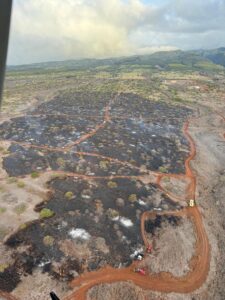UH joins in developing $25.6-million AI disaster warning system
University of Hawaii researchers are joining a nationwide team on a $25.6 million project to design advanced sensors that monitor the environment for natural disasters.
According to the university, the goal is to build the next generation of AI-powered smart sensors, enabling quicker updates and warnings.
“We’re ensuring Hawaii is at the forefront of innovation where it matters most,” said Jason Leigh, a professor at the college and the director of the Laboratory for Advanced Visualization and Applications. “Previously, we have had to transmit data to a far away point, analyze it and figure out, ‘Oh, is there a fire?’ Now the AI on the sensor itself can say there’s a fire and tell people immediately.”
Leigh said the grant will give UH students hands-on experience with cutting-edge AI. On Maui, the university has installed a similar sensor in Lahaina that connects to the internet via satellite.
The Lahaina project, separate from the $25.6 million grant, is also collecting climate and pollution data.
The latest $25.6-million initiative will place 300 advanced sensor systems across the country to monitor for natural disasters such as wildfires, floods and volcanic eruptions. Leigh said the team plans to deploy two to three sensors across the Hawaiian Islands next year at sites that are still to be determined.
The UH Manoa team comprises Leigh and Chris Shuler, Han Tseng, Anke Kügler and Tom Giambelluca of the UH Mānoa Water Resources Research Center.
In Hawaii Volcanoes National Park, a sensor has been used by UH students to test generative AI tools that analyze real-time data from Kilauea. Their early work demonstrated how AI can help answer basic but important questions, such as whether an eruption is underway.
Four university-led projects have received roughly $800,000 in expedited RAPID grants from the National Science Foundation following the 2023 Maui wildfires.
RAPID funding is used for proposals that have a severe urgency with regard to the availability of or access to data, facilities or specialized equipment, including quick-response research on natural disasters.
Three projects focused on data science have a concentrated effort to help prevent and react to wildfires in Hawaii.
They include a multi-hazard monitoring and detection system, computer modeling to assist wildfire response, and wildland and urban fire modeling using high-performance computing. The projects are looking at contributors to fires such as invasive grasses and non-native trees such as cook pines and eucalyptus.
The fourth project focuses on the human element and involves university researchers meeting with educators, youth, community members and cultural practitioners.
“We are deeply pained by the tragic loss of lives and property in the Lahaina fire,” Leigh said. “It’s a somber reminder of the powerful forces of nature that are poised to impact our islands at any time. We hope that our insights and advancements in state-of-the-art technology can help pave the way for better understanding and perhaps preventing such heart-wrenching incidents in the future.”



